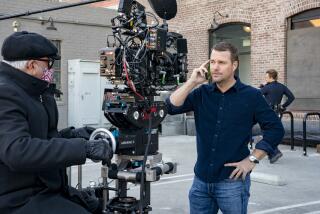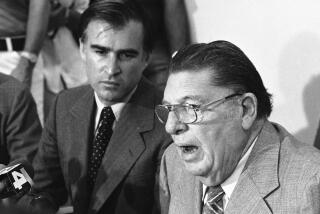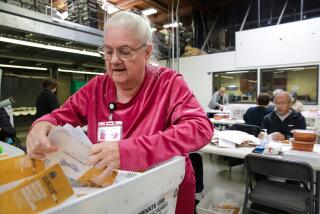Tax Collector Brings Old Money Back Home to Ventura County
- Share via
The currency looks as foreign as a ruble. But to Ventura County Tax Collector Hal Pittman, it’s money from home.
Pittman owns the largest known collection of antique bills issued by Ventura County banks at the turn of the century.
They are rare, antique bills that chronicle Ventura County’s banking history and the families that helped shape the county in the early years.
Pittman has spent the past several years in an exhaustive search for the treasured bills.
“It’s the thrill of the chase, shall we say,” said Pittman, popping open a brown leather briefcase filled with crisp, green bills.
The earliest bills in Pittman’s collection date from 1863, the year Abraham Lincoln signed the National Currency Act. The act established 12,000 national banks, five of which were in Ventura County. The move was initially meant to help finance the Civil War, but the currency remained in circulation for many decades after the conflict ended.
Bankers who participated had to purchase federal bonds. They were also allowed to issue federal currency.
The paper money issued from the local banks display the signatures--not stamps--of famous men of the county. They were bankers who would eventually have a city, a library, a school and streets named after them: Henry Thomas Oxnard, Eugene Preston Foster, Thomas Robert Bard, Charles Collins Teague and Larkin Snodgrass, to name a few.
Each bill bears the name of the city and state in which the issuing bank was located. The five countywide banks were in Ventura, Oxnard and Santa Paula. Nearly 700,000 bills of all denominations were issued from the local banks before Congress in 1935 stopped allowing federal banks to issue notes.
Pittman, a former banker himself, owns about a dozen of the roughly 100 Ventura County national bills still known to exist. Each varies in value from a few hundred dollars to $5,000. He tracked them down from as far away as Florida, Illinois and Massachusetts.
“This is a beautiful note,” the normally reserved Pittman, who grew up in Ardmore, a small town in Oklahoma, said enthusiastically. The ornate ten-dollar bill encased in plastic was issued by the First National Bank of Santa Paula in 1904. It bore the signatures of the bank’s cashier, A.L. Shively, and bank President C.H. McKevett.
In one corner is a sketch of Ben Franklin flying a kite. In the other, an angel atop a bald eagle in flight, symbolizing liberty. The note is one of three known to exist and is worth about $5,000. It’s called a “brownback” because the front is forest green and deep maroon while the back is a chestnut color.
“It’s colorful and pristine, having never been circulated to any great extent,” Pittman said.
He tried to suppress a proud grin as he held up his prized bill.
“People don’t like smiling tax collectors,” Pittman explained. “When they see a smiling tax collector, they want to know what you’re up to.”
*
Pittman, 60, has collected the antique bills for seven years. He started after attending a work-related conference in Costa Mesa and noticed a framed bill on a wall bearing the name of a bank in Orange County.
“It’s too bad they don’t have some of these from Ventura County,” he told a colleague at the conference. When he returned to Ventura, he contacted an antique note dealer and began his hunt for local bills.
“I got hooked,” he said.
John Boise, also an avid collector of the Ventura County bills, considers Pittman to be friendly competition in the painstaking effort to acquire the heirlooms.
“We don’t try to cut each other’s throats or stab each other in the back,” said Boise of Santa Barbara. “I’m sure he might not tell me everything, and I don’t tell him everything. But there is a kindred friendship there.”
It’s not only the thrill of the hunt that keeps Pittman excited about his hobby. When he acquires a bill, he learns about the backgrounds of the banks and the bankers as if he were researching his family tree.
“I don’t buy these for the money, pardon the pun,” said Pittman, who takes his collection out of a bank vault only on rare occasions. “I buy them for the historical value. This is strictly a labor of love.”
Now, he is sharing his knowledge in a 72-page book for the Ventura County Historical Society. The Ventura County Museum of History and Art’s quarterly publication will be released next week.
Charles Johnson, the museum’s library and quarterly editor, said he initially hesitated when Pittman approached him with the idea.
“He walked up to me and started talking to me about bank notes,” Johnson recalled of the encounter nearly two years ago. “I had no idea what he was talking about.”
*
Finally, Pittman showed Johnson some of the bills.
“His eyes suddenly got big and he said, ‘Let’s do it,’ ” Pittman recalled.
“I immediately became interested,” Johnson said. “I had thought he might be talking about bank loan documents. I had no idea this was actual money, signed by primary historical figures. I had never heard of it before.”
Pittman, the county’s tax collector for 12 years, dove into the project. He said he began spending every spare moment at his home computer or interviewing relatives of the early bankers.
“It’s wonderful when you can find someone like Hal Pittman who is so focused on one subject,” Johnson said. “He knows more than anyone alive about national currency produced in Ventura County.”
Pittman is scheduled to be at the museum Dec. 5 for a book-signing party. Of the 3,000 copies to be printed, 2,500 will be sent to museum members and the rest will be on sale for $15.
Although ecstatic about the project, Pittman said there will be no sequel for the quarterly, “Money From Home.”
The two-year project, he said, has prevented him from spending time with his wife of 31 years, Bobbie.
“My dear wife said if there was to be a sequel, I would have to call it, ‘Home Alone,’ ” Pittman said.
More to Read
Sign up for Essential California
The most important California stories and recommendations in your inbox every morning.
You may occasionally receive promotional content from the Los Angeles Times.










